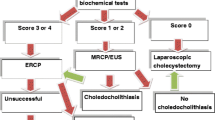Abstract
Background: There has been a dramatic increase in the number of endoscopic retrograde cholangiograms (ERC) performed on patients who are candidates for laparoscopic cholecystectomy (LC). The majority of these procedures result in normal findings. This study is an attempt to determine useful clinical criteria and strategy for predicting the presence or absence of common bile duct stones (CBDS) and the need for ERC in patients who are candidates for LC.
Methods: The observational portion of this study explored laboratory and ultrasound data from 134 consecutive patients who had undergone preoperative ERC, followed by LC, over a 4-year period. The data were then analyzed by multivariate logistic regression to determine the best models for predicting the presence or absence of stones in the common bile duct. Models using gamma glutamyl transpeptidase (GGT), alkaline phophatase (AP), common bile duct diameter (CBDIA), and amylase (AMY) were then evaluated retrospectively in 36 additional patients (validation group).
Results: A model based on GGT and common bile duct diameter as positive predictors and amylase as a negative predictor correctly classified 78% of the patients in the validation group. This model resulted in a negative predictive value (NPV), positive predictive value (PPV), sensitivity, and specificity of 0.88, 0.68, 0.87, and 0.71, respectively. The model utilizing AP was almost as effective. This model resulted in a NPV, PPV, sensitivity, and specificity of 0.83, 0.67, 0.80, and 0.71, respectively.
Conclusions: Although a number of laboratory values and imaging techniques correlate with the presence or absence of CBDS, our study confirms that individually they have poor predictive value. Our data and models suggest that elevated serum amylase is a negative predictor for CBDS. Elevated GGT and/or AP with widened CBDIA and normal AMY strongly suggest the presence of CBDS and the need for preoperative ERC. Elevated GGT, AP, or widened CBDIA with elevated amylase, in the absence of clinical pancreatitis, may suggest that small stones have passed through the ampulla of Vater and that the CBD is generally cleared of stones.
Similar content being viewed by others
Author information
Authors and Affiliations
Additional information
Received: 10 July 1998 Accepted: 18 September 1998
Rights and permissions
About this article
Cite this article
Barr, L., Frame, B. & Coulanjon, A. Proposed criteria for preoperative endoscopic retrograde cholangiography in candidates for laparoscopic cholecystectomy. Surg Endosc 13, 778–781 (1999). https://doi.org/10.1007/s004649901097
Published:
Issue Date:
DOI: https://doi.org/10.1007/s004649901097




